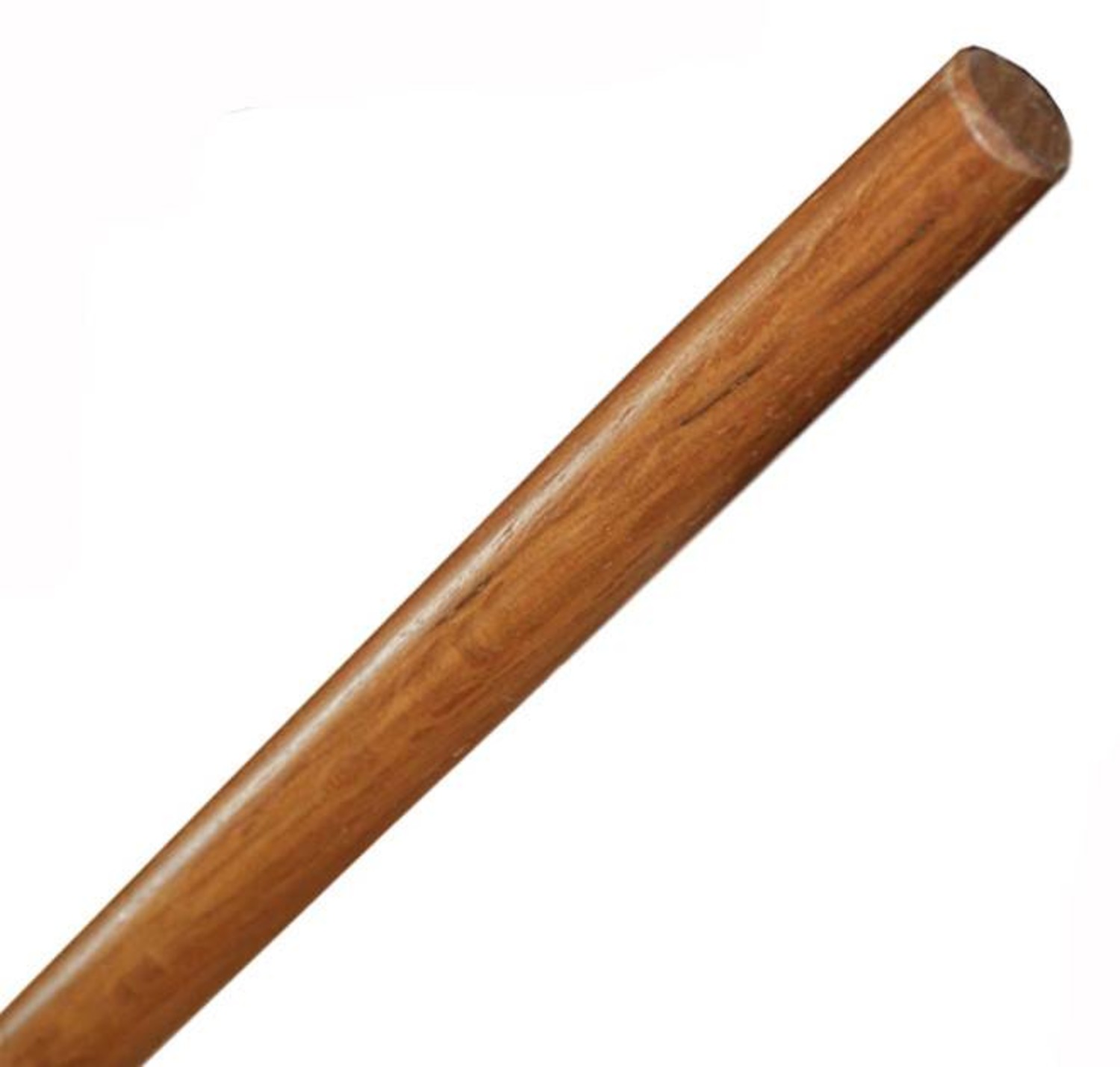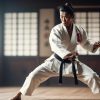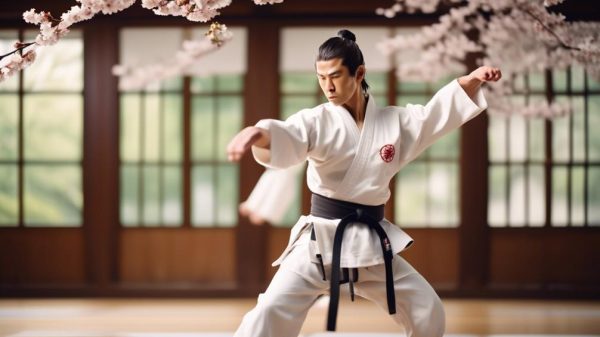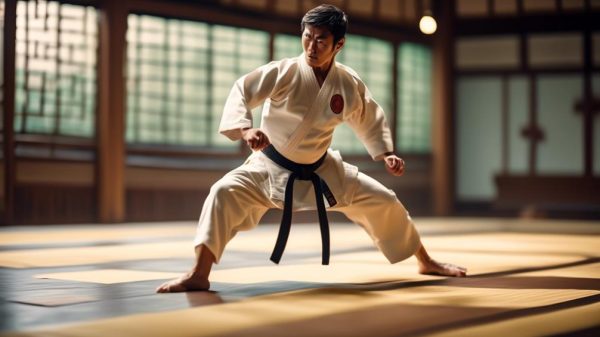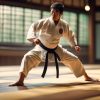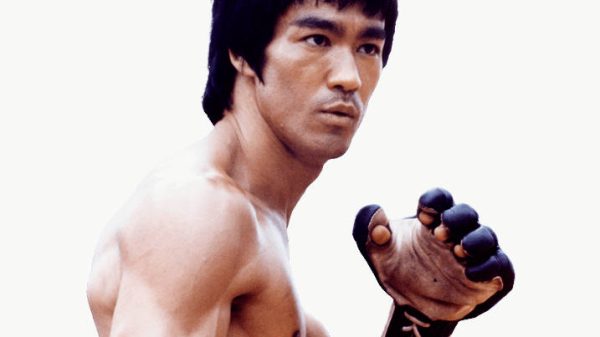Hanbo arts teach wielding the hanbo – a short wooden staff just over arm’s length. Skills build quick reflexes plus versatile attacking and defending.
Spinning, jabbing, cutting, blocking and striking using the hanbo improves hand-eye coordination and body motion unity through repetition. Grips take practice too!
Students start partner drills slowly, safely building precision and control. Gradually pace then coordination accelerates to match self-defense speed while managing force.
Blending defenses into counters mirror flowing energy seen in other sticks or sword methods adapted for the compact hanbo. Gripping correctly enables fluidity.
Mastering elusive hanbo movements sharpens the senses. Pairs dance displaying exceptional vision, intuition and control after diligent basics polish reflexes.
Key Takeaways
- The short hanbo staff allows quick wrist and arm movements for both compact yet versatile offensive striking and defensive blocking motions. Agility develops.
- Precision grip adjustments facilitate flowing transitions between spinning, deflecting, thrusting techniques – enabling counters to emerge spontaneously from defenses.
- Drills with a partner stress control and defensive sensitivity when judging proper distancing to halt attacks just short of contact as reflexes heighten.
- Repeating fundamental striking patterns, changing grips, and practicing footwork ingrain instinctive reactions so minimal thoughts slow motion as intuition guides body.
- Mirroring the harmony evident within Eastern martial arts philosophy, Hanbo principles echo yielding, redirecting opponent energy and effortless counterattacking.
- Mastering efficient physiology and condensed but holistic motions embodies Hanbo subtlety – making maximum impact through minimal movements.
Dedicated Hanbo basics forge an acute awareness and spontaneous fluidity between attacking and defensive movements using the short staff.
The Hanbo’s History
The Hanbo has a rich history in Japanese martial arts, serving as a versatile weapon for samurai to counter and control adversaries wielding swords.
This three-foot wooden staff, steeped in the tradition of feudal warfare and law enforcement, became a staple in the arsenal of the feudal police to adeptly arrest armed criminals.
Practitioners of Hanbojutsu explore techniques that capitalize on the weapon’s length to gain leverage, enabling them to maneuver within an opponent’s sword range.
Pokes, thrusts, blocks, and strikes form the foundation of this close-range combat style, designed for subduing opponents rather than causing harm.
Through dedicated training, individuals learn to wield the Hanbo with precision, effectively striking and pinning an attacker’s arms.
Building on the principles of Hanbojutsu, other arts such as Bojutsu and Jojutsu offer complementary weapons training, enhancing proficiency with the Hanbo.
By integrating cane-based techniques, martial artists expand their repertoire, wielding the Hanbo with the same ease as traditional canes.
Embracing this path embodies the strategic depth and practical application that are characteristic of Japanese martial arts.
Key Features Explained
Understanding the core principles of Hanbojutsu reveals its focus on mastering the unique traits of the hanbo for effective close-quarters combat.
This Japanese martial arts style differs from those centered on sword techniques or the long pole weapon known as the bo, as it utilizes a more versatile and concealable wooden rod.
At a length of three feet, the Hanbo is adept at both offensive and defensive maneuvers, including pokes, thrusts, and blocks essential for subduing an opponent.
The unassuming staff used in Hanbojutsu possesses remarkable control and precision. The techniques and training of this martial art emphasize fluidity and adaptability, drawing parallels with training in Okinawan weapons, yet distinct in application.
Notably, Kenjutsu focuses less on short-range tactics, while Bojutsu, a martial arts discipline, employs a longer staff, necessitating different spatial awareness.
For practitioners seeking to refine their skills, exploring instructional videos and specialized Aikido books can supplement their martial arts training.
These resources enhance understanding of the nuanced aspects that define Hanbojutsu, ensuring that every strike and block with the hanbo is executed with utmost efficiency and effectiveness.
Selecting Your First Hanbo
Selecting the right hanbo is essential, and it starts with finding one that suits your stature. A standard three-foot length typically works well.
Look for a hanbo crafted from durable materials like oak or hickory to withstand rigorous training.
Additionally, it’s crucial to consider the balance of the hanbo; choose one with a weight that feels comfortable and provides optimal control.
Hanbo Material Choices
Selecting the appropriate material for your Hanbo is essential for aligning the tool’s weight and flexibility with your training requirements.
It will significantly influence your ability to perform techniques effectively and impact the overall effectiveness of your martial arts training.
The following options are worth considering:
- Oak: This material provides weight and resilience, enhancing your strength training within Japanese martial arts styles that focus on sword techniques.
- Hickory: Renowned for its durability and shock resistance, making it ideal for rigorous Short Staff arts training.
- Rattan: Known for its lightness and pliability, allowing for swift movements, making it ideal for martial arts styles that prioritize speed in stick handling.
Appropriate Hanbo Length
When selecting a hanbo, it’s crucial to choose the appropriate length, which should roughly measure up to your armpit—about 3 feet—to ensure optimal reach and control during your martial arts practice.
In traditional Japanese martial arts, particularly those focused on sword fighting, wielding a hanbo of this length allows for precision in close-range combat.
This is essential for maneuvering inside an opponent’s guard in a martial arts style developed for efficiency.
Your martial arts instructor will emphasize the importance of choosing the right hanbo to prevent injuries and ensure proper technique.
When practicing martial arts techniques and exercises with a long staff, ensure that these exercises are supervised to master the art of hanbojutsu.
Your first hanbo is a foundational tool, setting the stage for your mastery.
Hanbo Weight Considerations
Understanding the importance of selecting the right weight for your hanbo is crucial. Along with ensuring its length aligns with your armpit, it’s equally vital to assess its weight to match your agility and striking needs.
When choosing your first hanbo, consider the following key factors:
- Balance and Comfort: Your hanbo should feel like a seamless extension of your arm, providing comfort and balance to execute martial arts techniques and exercises with precision.
- Material and Durability: Opt for a durable wood that can withstand the rigorous practice of martial arts styles, ensuring longevity and reliability during training.
- Personal Strength: Match the hanbo to your physical capabilities. Choosing a weight that complements your strength will enhance your ability to master martial arts techniques that focus on fluidity and impact.
Under the guidance of a martial arts instructor to gain a deeper understanding of the dynamics, and supervised by a trained professional, your hanbo practice will become an integral element of your mastery of Japanese martial arts. Whether they’re focused primarily on sword fighting or other disciplines that had significant influence.
Basic Grip and Stance
When starting to learn the hanbo, it’s essential to focus on your grip. Position your lead hand near one end of the hanbo, and place your other hand down the shaft to maintain control.
Your stance serves as the foundation for your movements, so it’s crucial to keep it stable and balanced.
Hanbo Holding Techniques
Hanbo Holding Techniques
Properly grasping the hanbo is essential for executing powerful strikes and maintaining solid defense in martial arts. Achieving mastery requires precise training. Here’s the recommended method for holding your hanbo:
- The Basic Grip: Position your dominant hand near the center of the staff, ensuring a firm yet flexible grip with your fingers.
- The Stance: Stand with your feet shoulder-width apart and knees slightly bent to uphold balance and readiness.
- Posture: Maintain a straight back and relaxed shoulders to facilitate swift and controlled movements.
These techniques are deeply entrenched in Japanese martial arts, particularly centered on sword fighting, and necessitate continual honing. Martial arts books can serve as valuable supplements to the guidance provided by a qualified martial arts instructor. It’s important to recognize that martial arts encompasses more than physical ability; it involves the seamless integration of mind and technique.
Stance Fundamentals
Fundamental Stance Techniques
Understanding the fundamentals of stance is crucial in Hanbojutsu to ensure stable and agile movements. As you delve into martial arts focused on weapons, particularly Japanese martial arts, stance fundamentals form the bedrock of your training.
Footwork and balance are paramount; they empower you to maneuver and strike with precision.
It’s important to find a good instructor who can provide personalized feedback to help correct any nuances in your form, preventing injuries and ensuring the information being taught translates into skillful, controlled practice.
Your journey in Hanbojutsu builds from these foundations.
Fundamental Strikes and Blocks
To effectively maneuver your Hanbo in combat, mastering fundamental strikes and blocks is crucial.
These include quick jabs at vulnerable spots, powerful penetrating strikes, and defensive actions to redirect or halt an opponent’s attack.
These techniques are essential for close-range combat, allowing you to disrupt your opponent’s balance and close in on them effectively.
Remember, these techniques require precision and a seamless flow, similar to other martial arts, and seeking guidance from a qualified instructor is important for refining your skills.
With dedicated practice, these fundamental moves will become instinctual responses.
Advanced Hanbo Techniques
Enhance your combat skills by mastering advanced Hanbo techniques, where intricate strikes and joint locks become second nature. Immerse yourself in martial arts focused on weapons, particularly the Japanese martial arts that combine elements of precision and fluidity.
Your journey into these advanced realms requires an understanding that the Hanbo is more than a tool; it’s an extension of your will.
As you delve into each technique at your martial arts class, absorb the principles behind the movements.
Naginatajutsu, a Japanese art focused on the long staff, offers insights into leverage and control that can enhance your Hanbo skills. The advanced techniques you’ll learn aren’t mere choreographies; they’re strategic solutions to real combat scenarios.
Your dedication to practice, complemented by the guidance taught by your martial arts instructor, will ensure that every block, strike, and maneuver is executed with confidence.
Remember, martial arts books are great resources, but they’re no substitute for the hands-on experience you gain on the mat.
Advanced Hanbo techniques aren’t just learned; they’re felt and internalized through relentless refinement. Embrace this path, and the long staff will become a formidable ally in your martial arts journey.
Training Drills and Exercises
Training Drills and Exercises
Developing proficiency in advanced Hanbo techniques allows for the integration of dynamic training drills and exercises into your routine, refining your skills and elevating your martial abilities.
As you delve deeper into the world of Japanese martial arts and Taiho Jutsu, or police stick fighting, your training transcends repetition, evolving into a captivating art form.
Here are three essential drills to consider:
- Solo Kata Practice: Envision executing precise strikes and blocks with the Hanbo, seamlessly transitioning from one movement to the next, not only honing technique but also creating a rhythmic flow akin to a combat dance.
- Partner Disarm Drills: Imagine engaging with a partner in a controlled setting, both practicing the art of disarming and neutralizing threats. It’s a strategic interplay of anticipation and reaction, demanding mental and physical acuity.
- Conditioning Circuits: Visualize yourself progressing through a circuit that challenges endurance and fortifies your grip on the Hanbo—incorporating tire flips, sprints, and targeted strength training—crucial for an art form that requires agility and power.
Sticking to certain daily practice drills does more than sharpen combat abilities. Diligent routines also lock in cultural wisdom.
The essence behind motions reveals deeper teachings about focus, self-mastery, and an inner strength that spurs growth. Inheriting these gems takes mindfulness.
Preserving meaningful ritual enriches students’ paths beyond trophies. Integrating once foreign wisdom into your local community can spread positive ripples too.
Hanbo in Self-Defense Scenarios
The Hanbo, a simple three-foot wooden staff, can be a valuable asset in self-defense scenarios. With its centuries-old martial arts techniques, this Japanese tool offers precision and power.
In self-defense, the Hanbo’s versatility is evident in techniques that can disarm and incapacitate an attacker.
Techniques and Their Impact
- Pokes: Targeting the attacker’s torso or face, this technique creates necessary distance.
- Strikes: Targeting the limbs or head, this technique incapacitates the attacker.
- Blocks: Used to prevent injury from incoming attacks.
Frequently Asked Questions
What Does Hanbo Mean in Japanese?
In Japanese, ‘hanbo’ refers to a traditional weapon known as the half-staff, commonly used in martial arts. Mastery of combat applications and self-defense is achieved through dedicated hanbo techniques, stance work, and rigorous training drills for skill development.
What Is the History of the Hanbo?
The Hanbo has its roots in Feudal Japan, where it originated as part of a samurai’s arsenal. Over time, it transformed into a fundamental tool for martial arts training, specializing in combat techniques, stick fighting, and defensive strategies as part of the traditional weapon evolution.
What Is Japanese Karate Called?
You are exploring the ancient discipline of Karate-Do, where the evolution of Shotokan, the basics of Kyokushin, and the techniques of Goju Ryu blend with the philosophical Wado Ryu and various Shito Ryu styles. This fusion refines your practice of kata and progression through belt levels, embodying the essence of Japanese Karate.
Can Aikido Be Used for Self Defense?
Yes, Aikido is effective for self-defense. Its techniques are practical and martially effective in real-world situations, focusing on defensive strategies, situational awareness, and Aikido philosophy rooted in combat principles and physical conditioning.

